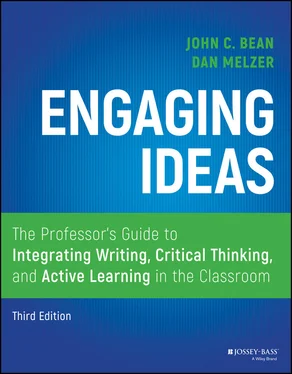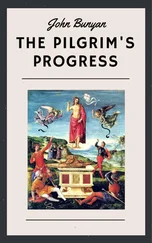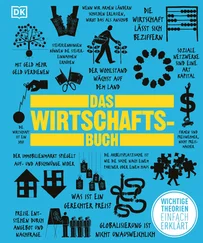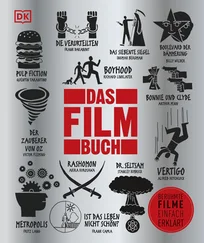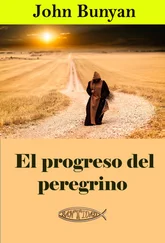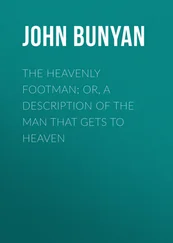By contrast, addressing professional scientists “orients students to adopt the persona of expert insiders who are communicating with other expert insiders” (22). The authors demonstrate that writing to a practicing scientist about an authentic experiment led to more expert scientific thinking from their students as well as to substantial improvements in their writing.
Whereas this chemistry project focused on writing to professionals, a second project, led by finance professor David Carrithers, asked students to write to a lay audience—in this case a small business owner with no background in finance or quantitative analysis. Carrithers asked students to do a case analysis of a finance dilemma faced by the business owner. Students were then asked to write a memo to the owner recommending a course of action (Carrithers and Bean, 2008; Carrithers, Bean, and Ling, 2008). Carrithers specified a lay audience not only because finance professionals often work with nonexpert clients but also because addressing a lay audience forces students to avoid finance jargon—a constraint that requires an extra dimension of critical thinking. Here is his reasoning (Carrithers and Bean, 2008):
Students, we surmise, tend to find comfort in jargon. They can memorize the terms and thus feel that they sound like finance professionals without fully understanding the concepts they represent. However, it takes considerable control of the concepts to be able to explain them to a nonexpert audience. Besides revealing weak communication skills, use of jargon may thus be evidence of a fundamental inability to use financial concepts in unfamiliar settings. (19)
What Carrithers and his coauthors discovered in the initial phases of their finance project is that students were surprisingly resistant to writing to a lay audience. With few exceptions, despite the assignment's admonition to address an owner who had no insider knowledge of finance, students continued to imagine the teacher as reader. Students loaded their recommendations with finance jargon and even attached pages of Excel spreadsheets that would make sense only to a finance expert. The research team interviewed a representative sampling of students to discover why they didn't adapt their message to the assigned audience. Their reasons were instructive:
Students didn't think the instructor was serious about writing to a lay audience. They saw the owner‐as‐audience feature as simply a way to dress up an algorithmic problem with the trappings of a “story problem.” They assumed that the teacher was interested only in their algorithmic calculations and their correct use of finance jargon.
They didn't think they would sound professional unless they used jargon; they felt they would be dumbing down their knowledge if they took the lay audience requirement seriously. They even thought the business owner would want them to use jargon.
They didn't realize the importance of walking in the shoes of business owners who needed bottom‐line advice and didn't need to know the technical calculations that yielded the advice. Until prompted by the interview questions, they didn't realize that the owner—unlike the instructor—would be confused by the finance jargon and Excel spreadsheets. They also didn't realize that they often buried (or didn't supply at all) the actual advice and supporting information that the owner needed.
They didn't see any transference between a previous course in business writing and the case study assignment in the finance course. The previous writing course stressed analysis of audience and purpose as the first step in producing a memo. This instruction didn't transfer to the finance course, apparently because students regarded the curriculum as a sequence of isolated courses with little connection to each other.
These findings support the frequently encountered observation that students write to the teacher even when they have been assigned a “real world” audience. As Anne Beaufort (2007) puts it in her own study of students' gradual acquisition of rhetorical knowledge, “School takes precedence; it is more immediate, so the more distant target audience cannot be fully imagined” (132). However, Beaufort shows how students make progress, sometimes quickly, when teachers stress the importance of imagining the needs of the reader. Our own research supports Beaufort's conclusion.
Helping students think about purpose, audience, and genre teaches them rhetorical concepts that have great explanatory power. What follows in table 3.1are examples of the kinds of questions that instructors can encourage students to pose about any disciplinary writing assignment.
TABLE 3.1Sample Questions to Spur Rhetorical Thinking
| Question to Ask |
Purpose or Value of This Question |
| What is my level of expertise relative to my assigned audience? (Note: a student may be a novice relative to the instructor but an expert relative to someone else.) |
Helps writer determine an appropriate level of vocabulary and syntax as well as amount of background and development needed. |
| How do I want to change my readers' view of my topic? |
Helps writer establish a contestable thesis in conversation with alternative views. |
| How much does my audience already know about the problem/issue I am addressing? How much do they care about it? |
Helps writer compose an effective introduction. The less an audience already knows about the writer's subject, the more the writer must provide background and context. To motivate the audience to care, the writer needs to make the problem vivid and to show why addressing the problem matters. |
| What's the “news” in my paper? What constitutes old information and new information for my audience? |
Helps writer connect new information to old information. Readers need to know the “news” quickly—usually in the title or subject line and certainly early in the introduction. But the news makes sense only when linked to the reader's previous knowledge and interests (old information). |
| How resistant is my audience to my thesis? |
Helps the writer accommodate resistant readers. Resistant audiences need assurance that the writer has thought about and respects alternative views; they'll expect the writer to anticipate possible objections and respond to them. |
| How busy is my audience? |
Helps writer think about reader's environment. Busy audiences often prefer concise documents with easy‐to‐scan structures and meanings up front. |
Helping Students Think about Genre
In addition to purpose and audience, another important rhetorical concept is genre. The term genre refers to recurring types of writing identifiable by distinctive features of structure, style, document design, approach to subject matter, or other markers. Genres usually arise from recurring cultural occasions or rhetorical situations with their own recognizable patterns. Certain cultural contexts or situations might call a writer to, say, compose a syllabus, a tweet, a complaint letter, or a scholarly article (all examples of genres) or to purchase a birthday card or a bumper sticker (genres that let you convey a message without much effort of your own). Any given genre has prototypical members that exemplify the most common features of the genre as well as innovative members that push the limits of the genre, playing creatively with its features. Some genres, such as the APA research report, are governed by strictly prescribed rules (the Publication Manual of the APA ) set forth by the discourse community. Other genres are more diffuse or open to a wide range of structures and style (popular magazine articles, blogs, the personal essay). Exhibit 3.1shows some typical examples of genres.
Читать дальше
